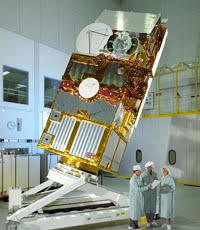| ESA’s second remote sensing satellite for monitoring the Earth’s
environment , ERS-2, was retired on 6th July 2011 after a fantastic 16 years of
operational service – see http://www.esa.int/esaCP/SEM3IP6TLPG_index_0.html. Having
far
exceeded its original design lifespan of 3
years, the
ERS-2, launched in 1995, has provided a valuable link allowing cross-calibration of missions from ERS-1 (launched in 1991) through ENVISAT
(launched in 2002) to the CryoSat era (launched in 2010).
MSSL were involved in the original specification of the Radar Altimeter (RA) flown on ERS-1 and ERS-2. The RA was designed to measure the
topography of the ocean and ice sheets to high precision for climate-related studies. We carried out the design and specification of the
operational processing chains implemented in the UK-PAF part of the Ground Segment. After launch we performed a cross-calibration of the ERS-2 RA
instrument with that on ERS-1, and again later with the RA-2 on ENVISAT. Since 1995 we have provided an operational QA service of the "WAP" data
products. Data from the 2 missions have been well exploited by UCL researchers, initially at MSSL but now forming the CPOM group at UCL. This has
resulted in many notable papers including publications in the journals Science and Nature. Today MSSL are prime on another ESA contract to deliver
an updated end-to-end processing system to re-process the entire RA and microwave radiometer (MWR) data archives from both ERS missions.
MSSL were also part of the consortium that provided ERS-2’s Along-Track Scanning Radiometer-2 (ATSR-2), an infra-red radiometer measuring sea
surface temperature (SST) for climate research. The ATSR series of instruments (ATSR on ERS-1, ATSR-2 on ERS-2 and AATSR on ENVISAT) have been
extremely successful in providing (so far) a 20-year record of SST to unprecedented accuracy and have recently been called the "gold standard" for
SST measurement. Crucial to achieving this accuracy was the on-board black-body calibration subsystem, which MSSL designed and calibrated for all
three instruments and also manufactured for ATSR and ATSR-2. For ATSR we also provided the Electronic Ground Support Equipment.
|

ERS-2 on test before launch. MSSL’s involvement was with the Radar
Altimeter, whose large parabolic antenna can be seen at the top of the
satellite, and with the Along Track Scanning Radiometer, whose curved
viewing ports can be seen to its right. Credit: ESA
|
![]() +44 (0)1483 204100
- Copyright © 1999-2005 UCL
+44 (0)1483 204100
- Copyright © 1999-2005 UCL